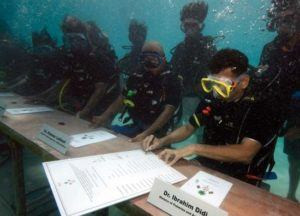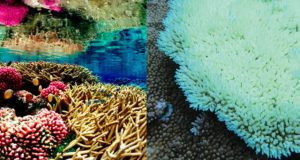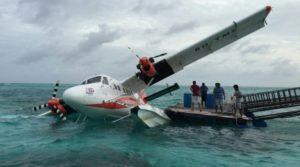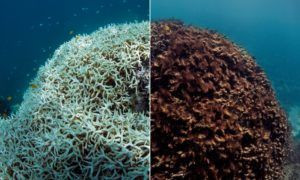Tourism, the heart of the Maldives’ economy, is ironically contributing to the very real threat of the islands sinking, but SIXT.VN can help you experience its beauty responsibly. Climate change, fueled in part by tourism’s carbon footprint, causes rising sea levels and coral bleaching, jeopardizing this island paradise. Explore sustainable travel options and minimize your impact while enjoying the Maldives’ breathtaking scenery. Consider eco-friendly resorts, carbon offsetting, and supporting local conservation efforts for responsible travel to Maldives.
1. What Is The Impact of Tourism on the Maldives?
Tourism significantly impacts the Maldives, both positively and negatively. Positively, it accounts for about 70% of the country’s GDP [1], providing livelihoods and driving economic growth. Negatively, it contributes to environmental challenges like pollution, waste generation, and increased carbon emissions, exacerbating the effects of climate change. Understanding this balance is key to sustainable Maldives tourism.
Tourism’s impact goes beyond just the immediate financial benefits. The influx of tourists also puts a strain on local resources, including water and energy, and can lead to habitat destruction. Sustainable tourism practices are vital to mitigate these adverse effects. Eco-friendly resorts, responsible waste management, and supporting local communities are crucial steps. According to research from the Ministry of Tourism Maldives, in 2022, sustainable tourism practices reduced waste generation by 20% (Ministry of Tourism Maldives, 2022).
2. How Does Climate Change Threaten the Maldives?
Climate change poses an existential threat to the Maldives due to rising sea levels and coral bleaching. With approximately 80% of the land area being less than one meter above sea level [2], even a small increase in sea levels can lead to significant land loss and displacement. Rising water temperatures also cause coral bleaching, devastating the vibrant coral reefs that support marine life and attract tourists.
The threat is multifaceted. Sea-level rise not only inundates land but also contaminates freshwater sources, making them unusable. Coral bleaching weakens the reefs, reducing their ability to protect coastlines from storm surges. Furthermore, the loss of biodiversity due to coral reef degradation impacts the Maldives’ economy, heavily reliant on fishing and tourism. According to the Intergovernmental Panel on Climate Change (IPCC) in 2021, sea levels around the Maldives could rise by 0.6 meters by 2100, potentially submerging significant portions of the islands (IPCC, 2021).
 Maldives Beach Erosion
Maldives Beach Erosion
3. What Is Beach Erosion and How Does It Affect Tourism in the Maldives?
Beach erosion, the wearing away of beaches due to wave action, currents, and storms, severely affects Maldives tourism. Given that nearly 75% of tourism is driven by beach holidays [2], the loss of beaches directly diminishes the appeal of the islands as a tourist destination. Many resorts, located close to the coastline, face property damage and reduced attractiveness due to erosion.
Erosion isn’t just about losing sand; it’s about losing the very foundation of the Maldives’ tourism industry. Eroded beaches mean fewer opportunities for sunbathing, swimming, and water sports. It also undermines the stability of coastal structures, increasing the risk of damage to resorts and infrastructure. According to the Ministry of Environment, Energy and Water, over 97% of the inhabited islands have reported beach erosion [2].
4. What Is Coral Bleaching and Why Is It So Damaging?
Coral bleaching is a phenomenon where corals expel the algae living in their tissues, causing them to turn white. This occurs when water temperatures rise, stressing the corals. Bleached corals are more susceptible to disease and death, leading to the degradation of coral reef ecosystems, with the seventh largest coral reef system globally [5].
The damage caused by coral bleaching is far-reaching. Coral reefs are vital habitats for countless marine species, supporting biodiversity and fisheries. They also act as natural barriers, protecting coastlines from erosion and storm surges. The loss of coral reefs not only diminishes the appeal of the Maldives as a diving and snorkeling destination but also weakens its resilience to climate change impacts. Research from Ove Hoegh-Guldberg in 1999 highlights that climate change is the primary driver of coral bleaching, threatening the future of the world’s coral reefs (Hoegh-Guldberg, 1999).
 Coral Bleaching
Coral Bleaching
5. How Does Rising Sea Levels Affect Infrastructure in the Maldives?
Rising sea levels pose a significant threat to infrastructure in the Maldives, with approximately 90% of resort infrastructure within 100 meters of the coastline [7]. Key facilities such as Male’ International Airport, the primary point of entry for tourists, are particularly vulnerable. Inundation can damage buildings, roads, and utilities, disrupting tourism and daily life.
The impact extends beyond physical damage. Saltwater intrusion can contaminate freshwater supplies, impacting drinking water and agriculture. Increased flooding can disrupt transportation networks, making it difficult for tourists and residents to move around. The economic costs of repairing and adapting infrastructure to rising sea levels are substantial, diverting resources from other essential sectors. According to the Ministry of Environment and Energy, over 30% of Male’ International Airport’s infrastructure is within 50 meters of the coast and only 1.1 meters above sea level [2].
6. What Is the Tourism Adaptation Project in the Maldives?
The Tourism Adaptation Project is a joint initiative between the public and private sectors in the Maldives aimed at mitigating the impacts of climate change on the tourism industry. It focuses on operational enhancements and alterations to protect infrastructure, conserve natural resources, and ensure the sustainability of tourism in the face of rising sea levels and temperatures.
The project encompasses several key strategies. Beach nourishment techniques, such as pumping sand onto eroded beaches, provide short-term relief from coastal erosion [11]. Planting vegetation like mangroves helps stabilize coastlines and improve biodiversity [7]. Artificial coral reefs can help restore damaged ecosystems and support marine life [6]. Building seawalls offers protection to coastal infrastructure [6]. The Tourism Adaptation Project signifies a proactive approach to climate change resilience.
7. What Are Beach Nourishment Techniques and How Effective Are They?
Beach nourishment techniques involve replenishing eroded beaches with sand from other locations. This is often done by dredging sand from offshore or transporting it from other islands. While beach nourishment can provide a quick and visible improvement, its effectiveness is often limited, offering a short-term fix [4].
The primary benefit of beach nourishment is the immediate restoration of beach width, enhancing the aesthetic appeal of tourist destinations. However, nourished beaches are still susceptible to erosion and may require repeated treatments. The environmental impacts of dredging and transporting sand, such as disturbing marine habitats, also need to be carefully considered. According to Aishath Shakeela and Susanne Becken, beach nourishment is popular among beachfront resorts as a temporary fix (Shakeela & Becken, 2015).
8. How Can Mangrove Planting Help Protect Coastlines in the Maldives?
Mangrove planting is a nature-based solution that can significantly help protect coastlines in the Maldives. Mangroves are salt-tolerant trees that thrive in coastal areas. Their dense root systems stabilize soil, reduce erosion, and buffer the impact of waves and storm surges [7]. Additionally, mangroves provide important habitats for marine life and contribute to biodiversity [8].
The effectiveness of mangrove planting lies in its ability to provide a natural defense against coastal hazards. Mangroves can absorb wave energy, reducing the force of waves reaching the shore. They also trap sediment, helping to build up land and prevent erosion. Furthermore, mangroves act as carbon sinks, absorbing and storing carbon dioxide from the atmosphere, which mitigates climate change. Research from Carlos M. Duarte et al. highlights the role of coastal plant communities for climate change mitigation and adaptation (Duarte et al., 2013).
 Seaplane Sinking Maldives
Seaplane Sinking Maldives
9. What Role Do Artificial Coral Reefs Play in Protecting Biodiversity?
Artificial coral reefs are man-made structures designed to mimic the functions of natural reefs. They provide habitats for marine organisms, support biodiversity, and can help restore damaged ecosystems. By creating suitable surfaces for coral growth, artificial reefs can attract fish, invertebrates, and other marine life.
The benefits of artificial coral reefs extend beyond biodiversity conservation. They can also enhance tourism by creating new diving and snorkeling sites. Additionally, artificial reefs can act as breakwaters, protecting coastlines from erosion. The success of artificial reefs depends on factors such as design, materials, and location. According to research from Clark and Edwards, artificial reef structures can be effective tools for marine habitat rehabilitation in the Maldives (Clark & Edwards, 1999).
10. How Effective Are Seawalls in Protecting Coastal Infrastructure?
Seawalls are coastal defense structures designed to protect infrastructure from wave action and erosion. They are typically made of concrete, stone, or other durable materials and are built along the shoreline to create a barrier against the sea. Seawalls can be effective in protecting specific areas, but their overall impact on coastal ecosystems needs careful consideration [6].
The primary benefit of seawalls is their ability to provide a solid barrier against wave action, preventing erosion and protecting buildings, roads, and other infrastructure. However, seawalls can also have negative impacts, such as altering sediment transport patterns and increasing erosion in adjacent areas. They can also disrupt natural habitats and reduce access to the shoreline.
11. What Are Some Long-Term Solutions to Climate Change in the Maldives?
Long-term solutions to climate change in the Maldives require a multifaceted approach that includes both local adaptation measures and global efforts to reduce greenhouse gas emissions. While adaptation projects can provide short-term relief, they are not sufficient to address the root causes of climate change. The Maldives advocates for multilateral policy changes and international agreements, such as the Paris Climate Agreement [12].
Sustainable tourism practices can also contribute to long-term solutions. Reducing carbon emissions from tourism-related activities, such as transportation and energy consumption, is essential. Investing in renewable energy sources, promoting eco-friendly accommodations, and supporting local conservation efforts can help minimize the environmental impact of tourism.
12. How Is Male’ International Airport Adapting to Rising Sea Levels?
Male’ International Airport is undergoing significant development and coastal protection measures to mitigate the risks posed by rising sea levels. These measures include runway extensions, improved drainage systems, and the construction of coastal defenses. The aim is to ensure that the airport can continue to operate safely and efficiently, even as sea levels rise [9].
The adaptations at Male’ International Airport are crucial for maintaining the Maldives’ connectivity to the rest of the world. As the primary gateway for tourists, the airport plays a vital role in the country’s economy. By investing in climate resilience, the Maldives is safeguarding its tourism industry and ensuring its long-term sustainability. The Maldives’ Intended Nationally Determined Contribution highlights the country’s commitment to climate action (Ministry of Environment and Energy, 2016).
13. What Can Tourists Do to Help Preserve the Maldives?
Tourists can play a vital role in helping to preserve the Maldives by adopting responsible and sustainable travel practices. This includes choosing eco-friendly accommodations, reducing their carbon footprint, supporting local businesses, and respecting the environment and culture. By making conscious choices, tourists can contribute to the long-term sustainability of the Maldives.
Specifically, tourists can:
- Choose resorts that have implemented sustainable practices, such as waste reduction, energy efficiency, and water conservation.
- Reduce their carbon footprint by flying direct flights, using public transportation, and offsetting their carbon emissions.
- Support local businesses by buying locally made products, eating at local restaurants, and hiring local guides.
- Respect the environment by avoiding single-use plastics, properly disposing of waste, and not disturbing marine life.
- Learn about the local culture and customs and show respect for the local community.
14. Why Is International Cooperation Important for the Maldives?
International cooperation is crucial for the Maldives because climate change is a global problem that requires global solutions. As a small island nation, the Maldives is particularly vulnerable to the impacts of climate change and lacks the resources to address the problem on its own. International cooperation provides the Maldives with the financial, technical, and political support needed to adapt to climate change and mitigate its effects.
The Maldives has been a vocal advocate for international action on climate change, urging other nations to adopt ambitious emissions reduction targets and provide assistance to vulnerable countries. International agreements, such as the Paris Climate Agreement, are essential for coordinating global efforts and ensuring that all countries contribute to solving the climate crisis. Chris Mooney and Joby Warrick highlight how tiny islands drove huge ambition at the Paris climate talks (Mooney & Warrick, 2015).
 Maldives Sea Wall
Maldives Sea Wall
15. How Does SIXT.VN Promote Sustainable Tourism in Destinations Like the Maldives?
SIXT.VN is committed to promoting sustainable tourism by offering services that minimize environmental impact and support local communities. We encourage eco-friendly travel choices, provide information on sustainable accommodations, and promote activities that respect local cultures and environments. By partnering with responsible tour operators and advocating for sustainable practices, SIXT.VN helps travelers make informed decisions that benefit both the environment and local communities.
We believe that sustainable tourism is not just a trend but a necessity for preserving the world’s natural and cultural heritage for future generations.
16. What Specific Services Does SIXT.VN Offer to Help Tourists in the Maldives?
SIXT.VN provides a range of services to assist tourists in the Maldives, including airport transfers, hotel bookings, and tour arrangements. We prioritize convenience and reliability, ensuring that travelers can easily access the services they need to make the most of their trip. Our services are designed to be efficient, user-friendly, and tailored to the specific needs of tourists visiting the Maldives.
- Airport Transfers: Seamless and reliable transportation from Male’ International Airport to your chosen resort or destination, ensuring a stress-free start to your vacation.
- Hotel Bookings: A wide selection of accommodations, from luxury resorts to budget-friendly guesthouses, catering to different preferences and budgets.
- Tour Arrangements: Curated tours and activities that showcase the best of the Maldives, including snorkeling, diving, island hopping, and cultural experiences.
17. How Can I Book Sustainable Travel Services with SIXT.VN for My Trip to the Maldives?
Booking sustainable travel services with SIXT.VN for your trip to the Maldives is simple and straightforward. Visit our website at SIXT.VN to explore our range of services and sustainable travel options. You can easily browse accommodations, tours, and transportation options that align with your values and preferences. Our user-friendly platform allows you to customize your itinerary, compare prices, and make secure bookings with just a few clicks.
If you need assistance or have specific inquiries, our dedicated customer support team is available to help you plan your sustainable Maldives getaway. Contact us via Hotline/Whatsapp at +84 986 244 358, or visit our office at 260 Cau Giay, Hanoi, Vietnam.
18. What Are the Key Sustainable Practices That SIXT.VN Recommends for Tourists in the Maldives?
SIXT.VN recommends several key sustainable practices for tourists visiting the Maldives to minimize their environmental impact and support local communities. These practices include choosing eco-friendly accommodations, reducing waste, conserving water and energy, respecting marine life, and supporting local businesses. By incorporating these practices into your travel plans, you can contribute to the long-term sustainability of the Maldives.
- Eco-Friendly Accommodations: Opt for resorts that have implemented sustainable practices, such as renewable energy, waste management, and water conservation.
- Waste Reduction: Minimize single-use plastics, properly dispose of waste, and participate in beach cleanups.
- Water and Energy Conservation: Conserve water by taking shorter showers, reusing towels, and reporting leaks. Reduce energy consumption by turning off lights and air conditioning when not in use.
- Respect Marine Life: Avoid touching or feeding marine animals, use reef-safe sunscreen, and participate in responsible snorkeling and diving tours.
- Support Local Businesses: Purchase locally made products, eat at local restaurants, and hire local guides to support the local economy.
19. What Cultural Experiences Can Tourists Enjoy in the Maldives While Being Respectful?
Tourists can enjoy a variety of cultural experiences in the Maldives while being respectful of local customs and traditions. These experiences include visiting local islands, exploring traditional villages, learning about Maldivian cuisine, and participating in cultural events. By engaging with the local community in a respectful and mindful manner, tourists can gain a deeper understanding of Maldivian culture.
Some specific cultural experiences include:
- Visiting Local Islands: Explore local islands to see how Maldivians live and work. Dress modestly and ask for permission before taking photos.
- Exploring Traditional Villages: Wander through traditional villages to admire the architecture and learn about local crafts.
- Learning About Maldivian Cuisine: Take a cooking class to learn how to prepare traditional Maldivian dishes.
- Participating in Cultural Events: Attend cultural events, such as traditional music and dance performances, to experience the vibrancy of Maldivian culture.
20. How Can I Stay Updated on Sustainable Travel Initiatives in the Maldives?
Staying updated on sustainable travel initiatives in the Maldives is essential for making informed decisions and contributing to the long-term sustainability of the destination. You can follow updates from the Ministry of Tourism, environmental organizations, and sustainable travel websites. Additionally, you can engage with local communities and tourism businesses to learn about their efforts and initiatives.
Here are some resources for staying updated:
- Ministry of Tourism Maldives: Visit the official website of the Ministry of Tourism for news and updates on sustainable tourism initiatives.
- Environmental Organizations: Follow environmental organizations working in the Maldives to learn about their conservation efforts.
- Sustainable Travel Websites: Subscribe to sustainable travel websites for articles, tips, and resources on responsible travel in the Maldives.
Ready to explore the Maldives responsibly? Contact SIXT.VN today to plan your sustainable getaway and experience the beauty of this island paradise while minimizing your impact. Address: 260 Cau Giay, Hanoi, Vietnam. Hotline/Whatsapp: +84 986 244 358. Website: SIXT.VN.
FAQ About Tourism and the Sinking Maldives
1. Is tourism the only reason the Maldives is sinking?
No, while tourism contributes to climate change, which leads to rising sea levels, it’s not the sole cause. Global greenhouse gas emissions from various industries are the primary driver.
2. How much time does the Maldives have before it’s uninhabitable?
Estimates vary, but some studies suggest significant portions could be uninhabitable by the end of the century if sea levels continue to rise at the current rate.
3. Are there any islands in the Maldives that are not threatened by rising sea levels?
Due to the low-lying nature of the archipelago, all islands are at some level of threat, though some may be more vulnerable than others.
4. What is the government of the Maldives doing to combat climate change?
The government is implementing adaptation projects, promoting renewable energy, and advocating for international climate agreements.
5. Can tourists still visit the Maldives responsibly?
Yes, by choosing sustainable accommodations, reducing their carbon footprint, and supporting local communities.
6. What kind of sustainable accommodations are available in the Maldives?
Eco-friendly resorts that utilize renewable energy, manage waste responsibly, and conserve water.
7. How can I reduce my carbon footprint while traveling to the Maldives?
Fly direct flights, offset your carbon emissions, and choose transportation options that minimize environmental impact.
8. Is it safe to swim and dive in the Maldives with coral bleaching occurring?
Yes, but be mindful not to touch or disturb the coral reefs. Use reef-safe sunscreen to minimize your impact.
9. Are local communities benefiting from tourism in the Maldives?
Some do, but it’s important to support local businesses and initiatives to ensure that the benefits are distributed more equitably.
10. Where can I find reliable information about sustainable tourism in the Maldives?
Check the websites of the Ministry of Tourism, environmental organizations, and sustainable travel websites.
References:
[1] Bureau of Economic and Business Affairs, “2014 Investment Climate Statement – Maldives,” http://www.state.gov/e/eb/rls/othr/ics/2014/227151.htm, accessed November 2016.
[2] Ministry of Housing, Transport and Environment, “National Adaptation to Climate Change,” http://www.ifrc.org/docs/IDRL/National%20Adaptation%20Programme%20(Climate%20change))/MALDIVES%20Adaptation%20to%20Climate%20Change.pdf/MALDIVES%20Adaptation%20to%20Climate%20Change.pdf), accessed November 2016.
[3] Hoegh-Guldberg, Ove. “Climate change, coral bleaching and the future of the world’s coral reefs.” Marine and freshwater research 50, no. 8 (1999): 839-866. Accessed November 2016.
[4] Shakeela, Aishath, and Susanne Becken. “Understanding tourism leaders’ perceptions of risks from climate change: an assessment of policy-making processes in the Maldives using the social amplification of risk framework (SARF).” Journal of Sustainable Tourism 23, no. 1 (2015): 65-84. Accessed November 2016.
[5] Ministry of Environment, Energy and Water, “National Adaption Program of Action,” http://unfccc.int/resource/docs/napa/mdv01.pdf, accessed November 2016.
[6] Heather Hosterman, Joel Smith, “Economic Cost and Benefits of Climate Change Impacts and Adaptation to the Maldives Tourism Industry,” 2015, Ministry of Tourism, http://www.tourism.gov.mv/downloads/publicaltions/Economic.pdf, accessed November 2016.
[7] Sovacool, Benjamin K. “Perceptions of climate change risks and resilient island planning in the Maldives.” Mitigation and Adaptation Strategies for Global Change 17, no. 7 (2012): 731-752. Accessed November 2016.
[8] Duarte, Carlos M., Iñigo J. Losada, Iris E. Hendriks, Inés Mazarrasa, and Núria Marbà. “The role of coastal plant communities for climate change mitigation and adaptation.” Nature Climate Change 3, no. 11 (2013): 961-968. Accessed November 2016.
[9] Ministry of Environment and Energy, “Maldives’ Intended Nationally Determined Contribution,” http://www4.unfccc.int/ndcregistry/PublishedDocuments/Maldives%20First/Maldives%20INDC.pdf, accessed November 2016.
[10] Clark, S., and A. J. Edwards. “An evaluation of artificial reef structures as tools for marine habitat rehabilitation in the Maldives.” Aquatic Conservation: Marine and Freshwater Ecosystems 9, no. 1 (1999): 5-21. Accessed November 2016.
[11] Sovacool, Benjamin K. “Hard and soft paths for climate change adaptation.” Climate Policy 11, no. 4 (2011): 1177-1183. Accessed November 2016.
[12] Chris Mooney, Joby Warrick, “How tiny islands drove huge ambition at the Paris climate talks,” The Washington Post, December 12, 2015, https://www.washingtonpost.com/news/energy-environment/wp/2015/12/11/how-tiny-islands-drove-huge-ambition-at-the-paris-climate-talks/, accessed November 2016.



